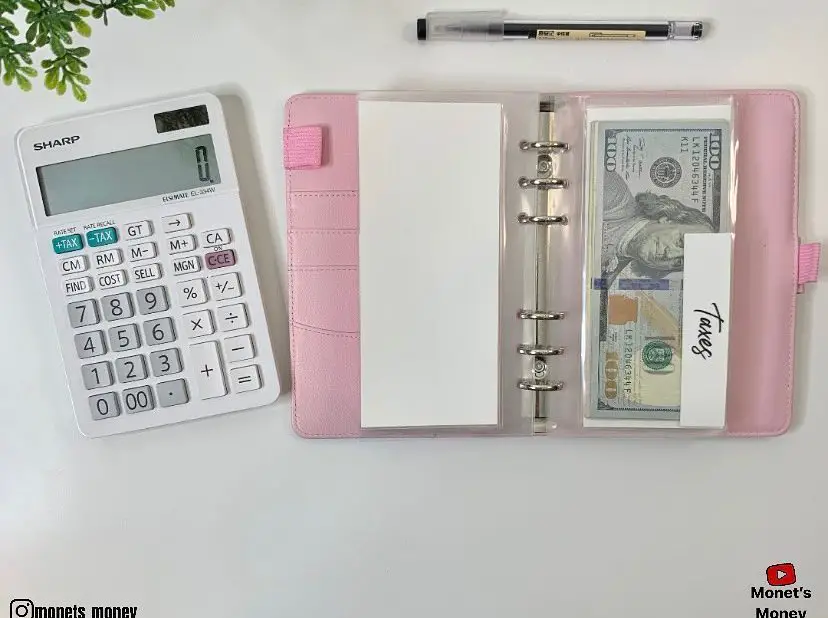Manicured nails count out crisp $10s and $20s before carefully and decisively putting them in glittery silicone envelopes, marked with labels such as “Food,” “Rent,” “Beauty” and “Car.” A soft voice explains how the YouTuber was able to pay for a new car with the thousands of dollars she saved. This is cash envelope stuffing, and for hundreds of thousands of viewers, this is both a new fascination and an old way to take control of their finances.
YouTube videos are quickly jumping on this budgeting technique, using it for personal gain, like how one YouTuber was able to save up for a new house, as well as spreading greater awareness to the community.
Click on one such video — say, PinkxBudgetz’s “July 2021 Cash Envelope Stuffing” — and it’s quickly clear what most videos are like. On the left, an iPad is displaying her budget breakdown. On the right side is a stack of bills that make up that week’s paycheck. As viewers watch, PinkxBudgetz flips open a small black binder filled with translucent envelopes, each labeled with her budget categories, and assigns the appropriate amount of cash for each. She goes on to explain that some weeks’ budgets are more or less depending on the past week’s spending, her priorities for the week and saving goals.
However, note that cash envelope stuffing isn’t a new phenomenon. It’s essentially an old-fashioned, “grandma’s style” way of budgeting, back when paper currency was the main form of payment and no one ever heard of digital payments.
But the phrase was coined and made popular by finance guru and radio talk show host Dave Ramsey. The earliest video of cash envelope stuffing was his video in 2010 that explained this approach to a news channel. He has also explained how to use this system for online payments, as well as automatically recurring payments.
“Jordan Page, FunCheapOrFree,” a popular lifestyle YouTuber with over 800,000 subscribers, has also created a video about this method in 2017 that now has over 1.6 million views.
The phenomenon gained traction starting in late 2020, helped by channels like PinkxBudgetz, BudgetWithBri and Monet’s Money, whose videos combined have a cumulative view count of over 7 million in the past year. There are videos for low-budget, college students and even high-budget ones if you happen to be fortunate or simply just enjoy watching stacks of $100 bills get counted.
Aside from the obvious educational aspect of these videos, there’s also something soothing about watching a person counting and putting away money. Perhaps we are living our financially responsible dreams vicariously through these videos or are drawn in by the ASMR-like sounds of bills being stacked and moved around.
So far, it’s a small niche, with most videos and channels catering to a relatively small audience on YouTube, but it has incredible potential. Not only is it a technique that everyone could benefit from, ensuring its wide appeal, but the very nature of its platform (YouTube) could cause cash envelope stuffing to be the next big thing in budgeting. As video-sharing platforms like YouTube or TikTok have increasingly turned into the optimal place to learn life skills, these cash envelope stuffing videos have the ability to inform a new generation of a tried-and-true method.
Being able to manage your budget well is a concern that applies to all adults (or people of any age, really) in life. This can be difficult in an era where spending is more convenient than ever. From one-tap payments, subscriptions, online flash deals and a culture of hyperconsumption and inflation, it is growing increasingly harder to make smart financial choices and save up for what really matters. Budgeting is a great first step, but people quickly find that this flies out the window when it comes to impulse purchases at grocery stores or during online shopping sprees. This is where cash envelope stuffing comes in.
Forget confusing Excel spreadsheets or money-management apps; cash envelope stuffing presents your financial situation in tangible, visceral ways that ensure you stick to your budget.
Let’s say your budget is $100 a week for groceries. Take out the amount from the ATM, deposit it in an envelope and label it “Groceries.’’ Going to the store with a predetermined amount to spend forces you to consider staying within the budgeted amount and serves as a visual reminder for when you are deciding whether to spend $8 on an unnecessary cookie butter spread or grab those candy bars at checkout. Furthermore, the cash envelope method means that there’s no “wiggle room” in the budget. If your bill is $101, well, you’ll have to put something back.
After all, once that cash is gone, it’s gone. Unlike credit cards and Apple Pay, both of which can incur the risk of overspending — as you can’t really “see” your bill soaring or your bank account draining away — having cash in your hand allows you to avoid impulse purchases you can’t afford.
Although modern alternatives to cash may be handy, the entire point of a cash-based budgeting and spending method is a test of willpower, and taking out the convenience factor can be helpful in curbing the urge to spend. Just like how putting your phone in another room or deleting apps can help limit screen time and mindless scrolling, using cash can actually make you spend less.
Logically, this makes sense — you don’t really know how much you’ve spent on groceries until the credit card bill comes in. But by that time, it’s way too late to change anything. But with cash envelope stuffing, it’s different.
Studies on the effects of spending using credit cards versus cash have been in existence since the late 1990s. The first group of studies to look at the influence of cards in depth was conducted by George Loewenstein and his colleagues and published in 1998 and 2001. Specifically, they looked at the role of “coupling,” or the purchase of a product and payment together, as happens with cash.
One of the many interesting findings was that paying in cash elicited greater psychological pain than other modes of payment. The reason behind this effect was that other methods, such as credit cards or other delayed forms of payment, “decouple” the actual purchase and the pain of paying for it. In other words, consumers created a buffer zone between the purchase of the product and the loss of their money (both psychologically and temporally).
Or, as Cornell University economics professor Robert Frank once said in an NPR interview, “Parting with it (cash) is just a more vivid sensation than the abstract act of signing a pledge to pay sometime later in the future.”
Even better, with cash envelope stuffing, anyone and everyone can get started with this money-saving method. You can make a quick trip to your nearest Dollar Store and grab some colored plastic envelopes and begin your system to revolutionize your financial situation. Or start saving already and make envelopes at home for free with a few sheets of paper and some tape or staples.
Note that with cash envelope stuffing, bills such as mortgage/rent, car payment, cell phone charges, cable television charges, electric bills and other fixed expenses can still be paid electronically, or on autopay. The cash method is really a personal challenge over the area where you have the most control over your money. The idea behind carrying a limited sum of physical cash is simply to manage how much you spend, using it as a quick visual.
Clearly, financial discipline is key to the success of this method. Cash envelope stuffing YouTube videos may be inspirational but remember that just like with dieting or working out, simply watching others do it is not enough to get up from the metaphorical couch. Cash envelope stuffing is simply a means to that end, and your future remains in your hands.

















